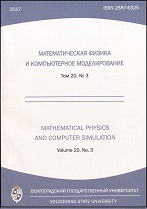|
Mathematics and mechanics
Stress-strain state of thick-walled pipe of an elastic composite in average isotropic material
A. S. Kravchuk, A. I. Kravchuk
Belarusian State University, Minsk
Abstract:
For the first time the boundary value problem is solved for a composite solid body without the application of non-local hypotheses about the smallness of representative volume of composite material, for which the effective characteristics are set. It is assumed that the variation of Poisson’s ratios for all the components of the composite material about the mean value is small, and therefore it is possible to use the condition of constancy of Poisson’s coefficients and its equality to the average value of all components of the composite material. Due to the peculiarity of this problem, it is not possible in the case of the composite material to separately consider the plane stress and the plane strain state of the pipe, because both these states participate in the evaluation of the stress-strain state of the studied object, according to the standard hypothesis of Voigt and Reuss. An approximation for Hill average value of stresses and strains for representative volume are obtained. Due to the fact that stress and displacement both on the inner and outer border are constant, their average values at any section of the boundary area are constant and equal to their original values. In this connection, from the methodological point of view to the Lame problem, it is shown that solutions built using Voigt and Reuss hypotheses are self-sufficient and do not require the use of additional assumptions about the smallness of the averaging elements inside the elastic body. It was established that a solution for the stresses depend on the Voigt and Reuss mean values of the elastic moduli, and the deformations are determined only by the Reuss mean values of elasticity modulus. The formulas that determine the stress-strain state in composite average isotropic plane with the hole is obtained. These solutions can be used as estimates of stresses and strains in the cross section of soil around the pile using, for example, brown-pile method of their immersion in the permafrost conditions.
Keywords:
composite heterogenic material, discrete random variable, averaging, effective deformation characteristics, Voigt hypothesis, Reuss hypothesis, Hill approximation.
Citation:
A. S. Kravchuk, A. I. Kravchuk, “Stress-strain state of thick-walled pipe of an elastic composite in average isotropic material”, Mathematical Physics and Computer Simulation, 20:5 (2017), 39–48
Linking options:
https://www.mathnet.ru/eng/vvgum205 https://www.mathnet.ru/eng/vvgum/v20/i5/p39
|

| Statistics & downloads: |
| Abstract page: | 166 | | Full-text PDF : | 58 | | References: | 37 |
|




 Contact us:
Contact us: Terms of Use
Terms of Use
 Registration to the website
Registration to the website Logotypes
Logotypes








 Citation in format
Citation in format 